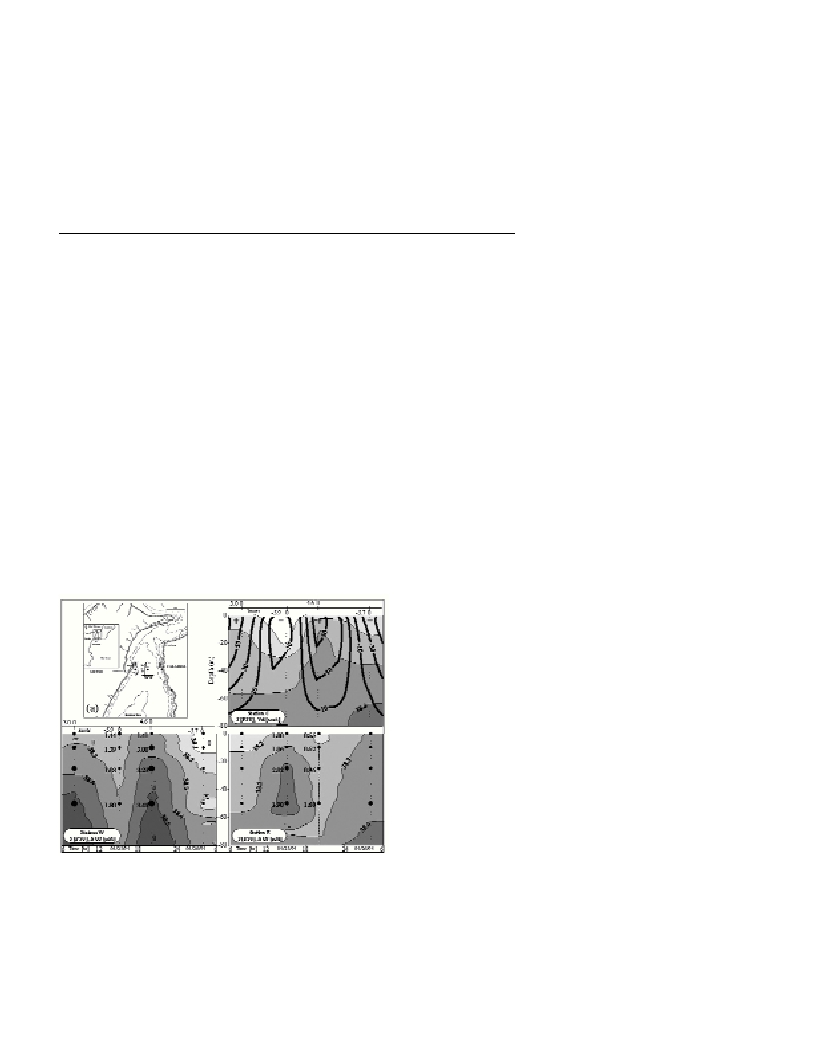HYDROBIOLOGIC OBSERVATIONS IN SYZYGY IN A LATITUDINAL SECTION
IN THE MESSINA STRAITS
F. Azzaro *, F. Decembrini, F. Raffa
IAMC-CNR, Messina, Italy - * azzaro@ist.me.cnr.it
Abstract
The effects of tidal streams have been investigated in the Messina Straits during April 1994 in syzygy through significant hydrologic
stations, at the same time of the stationary phase (slack waters) between low and high tide phases. Two distinct water masses with different
physico-chemical characteristics come from Tyrrhenian and Ionian Seas at different stages of the tide. When the current ?ows southward,
the Ionian water upwelling (highest salinity and nutrients) was most evident along the Calabrian coast, whereas along the Sicilian coast in
northward ?ow. Salinity and nitrate were positively correlated.
Keywords: Hydrology, nitrates, chlorophyl- a, coastal upwelling system, Straits of Messina
Rapp. Comm. int. Mer Médit., 37,2004
483
Introduction
In the Strait of Messina, upwelling events have been documented
since the beginning of this century (1), because their dynamics are
determined by the presence of tidal currents (with semi-diurnal phase)
and the consequent alternating presence of two water masses. These
coditions lead to semidiurnal periodic oscillations of the currents
?ows, of Tyrrhenian waters into the Ionic basin (southward current)
and vice versa (northward current), with a brief slack waters interval.
Moreover, coastal geomorphology is responsible for turbulence
phenomena as shown by the presence of internal waves. This leads to
the upwelling of Ionic waters (Levantine Intermediate Water origin),
which are colder, more salty and richer in nutrients in respect to the
Tyrrhenian surface waters (Atlantic Water origin).
The distribution of tracing parameters (such as temperature, salinity
and nitrates [2]) and the photoautotrophic biomass (standard methods
[3]) in a selected west-east section (3 stations: W, C, E) is discussed
(Fig. 1). Measurements were carried out (N/O Urania, April 1994) in
syzygy lunar phases, when the currents reach maximum intensity
(>5knots). The vertical profiles (0-80m) of the cross-sectional ?ows
of current across the transect for the time series at station C were
computed with the Hopkins method [4]. Measurements (CTD/rosette)
were performed during a 24 hour cycle in correspondence to the
4stationary phase (with slack waters), this to individuate the
upwelling of deep waters. In fact, the maximum chemical-physical
differences are manifested when the ?owing water has undergone less
mixing and better preserves the characteristics of its zone of origin [5].
Results and Discussion
The temperature measured in the whole water column showed
variation in the order of half degree (14.16
±
0.29°C), in both slack
phases. The salinity better evidenced the change from the southward
to the northward current. In the station-W, the distribution of
isohalines during a diurnal cycle ranged between 38.3 PSU in upper
waters and 38.6 PSU in bottom layer during the stationary phases after
northward current (Fig. 1). Since the tide changes, lower halines
values were found mainly in the last sampling (38.03 at the surface
and 38.32 PSU at the bottom). The distribution of isohalines in the
station-E was opposite to station-W, with surface values of 38.3 PSU
but in southward current, while in the opposite phase at surface the
salinity value was of 38.11 PSU. As shown in figure 1, in station-E
there were intruding water bodies able to modify the normal
stratification. In the station-C, the distribution of isohalines is similar
to station-W, with the saltier water during the two phases of northward
?ow. The speed of the current at station-C, calculated in slack phases
(Fig.1), introduces a periodic oscillations typical of the alternating of
the two tides. The values range between -50 and 70 cm/sec and the
isoalines show the prevalence of the northward current in this section.
During the stationary phase after northward current, (Figure 1) an
evident dissymmetry between West (2.77
±
0.80µM) and East coasts
(0.93
±
0.4µM) was observed for nitrate values, with concentration
maximum in the western side (3.43µM 50m), perfectly in agreement
with salinity values. In the opposite phase, these nutrients were more
similar from coast to coast (1.42
±
0.27µM station-W; 1.50
±
0.47µM
station-E). The nitrates at station-C were not very different for both
slack phases (1.84
±
1.07µM).
The enrichment of nutrients of the euphotic layer at the West coast
does not correspond to the same trophic activity. In fact, the va-
lues of chlorophyll-awere always low for both the tides
(0.14
±
0.05µg-Chla l
-1
station-W; 0.14
±
0.05µg-Chla l
-1
station-C;
0.12
±
0.02µg-Chla l
-1
station-E).
Conclusions
The characteristics of the water column, in the Straits of Messina,
change quickly between the southward and northward currents.
However, the maximum excursions were found for all the parameters
examined in northward currents, mainly in the western side in
agreement with hydrodynamic factors that result from the coastal
relief.
Upwelled waters along the western coast of the Straits were
nutrients-rich but plankton-poor (HNLC). Water column instability,
due to the turbulence caused by the alternating of the Ionian and
Tyrrhenian waters provokes unfavourable conditions for
phytoplankton growth as in calmer water.
References
1-Vercelli F., 1925. Il regime delle correnti e delle maree nello Stretto di
Messina. Comm. Inter. del Mediterraneo, Venezia, 1, 209 p.
2-Strickland J.F.H., Parson T.R. 1972. A pratical handbook of seawater
analisys. Bull. Fish. Res. Ed. Can., 167: 311 p.
3-Lazzara L., Bianchi F., Falcucci M., Hull V., Modigh M., Ribera
D’Alcalà’M., 1990. Pigmenti clorofilliani. Nova Thalassia, 11: 207-223.
4-Hopkins T.S., 1999. The thermohaline forcing of the Gibraltar
exchange. J. Mar. Syst., 20: 1-31.
5-Azzaro F., Decembrini F. and CrisafiE., 1995. Continuous survey of
upwelling in the Straits of Messina. Rapp. Comm. Int. Mer Médit., 34: 67.
Fig. 1. Location of the stations in the Straits of Messina (a); isohalines
distribution in all the stations, for nitrates in stations W-E [
•
], and for the
normal component of the velocity, across the transect at station C [
?
].
Estimated current speed (Knots) and direction (+=S
?
N; –=N
?
S) from
«Tavole di Marea I.I.M.M.».

